We dive into the similarities and differences between Qobuz and Spotify to see which platform is superior.
Spotify and Qobuz are well-established music streaming platforms that share notable similarities. One of which is their excellent music discovery algorithms.
Despite that, they’re still very different apps with unique offerings. For example, Qobuz has high-resolution audio, while Spotify has an extensive podcast collection. This makes it harder to determine which app is more worthwhile for you.
Fortunately, you can work around this by closely examining both platforms’ features. You can then prioritize those that complement your listening habits. Read on as we review everything you need to know about Spotify vs. Qobuz to help you do just that!
The Overview
Qobuz
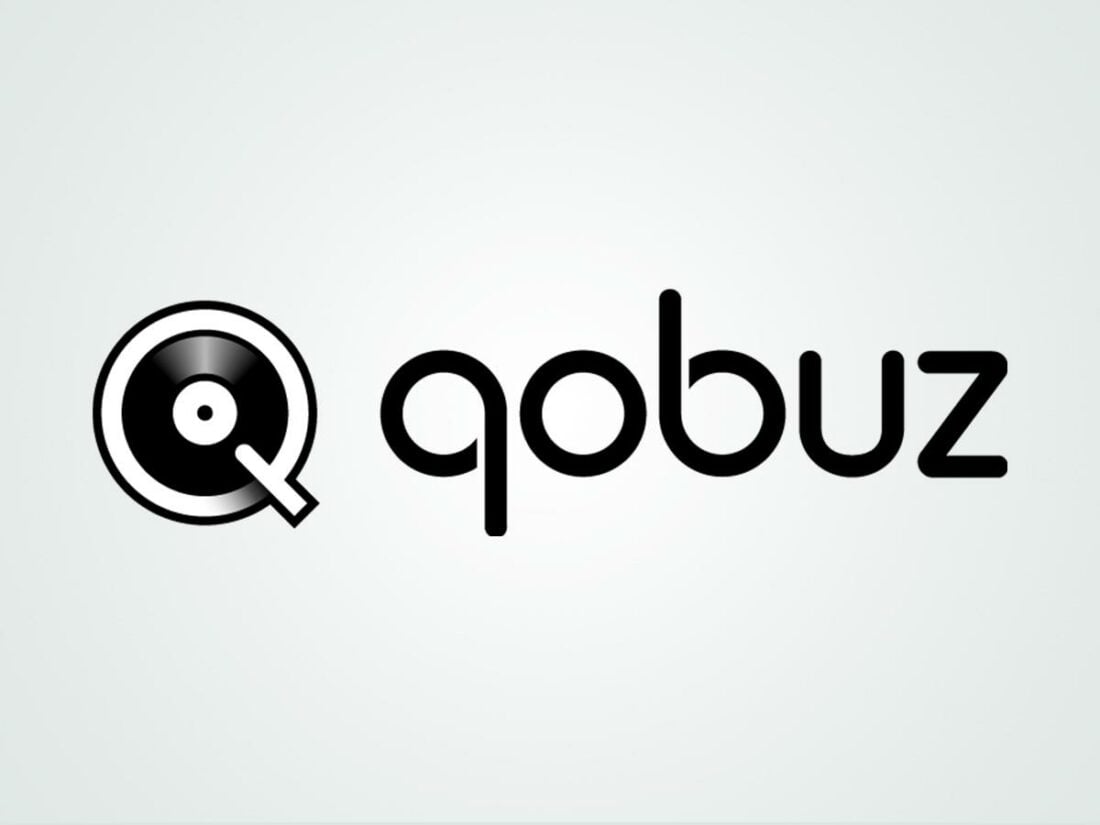
Qobuz is a French music streaming and download service launched in 2008 by Yves Riesel. Since its launch, Qobuz has expanded to 24 overseas markets, including the UK, the USA, Australia, Brazil, Portugal, and Chile.
The company focuses on music quality above all else, currently offering over 100 million tracks available in up to 24-bit, Hi-Res audio quality for online and offline streaming and purchase by more than 200,000 customers.
Spotify

Spotify is a Swedish audio streaming platform launched by Daniel Ek and Martin Lorentzon in 2008. The service is the largest on the market, available in over 180 markets worldwide and with more than 500 million users.
Spotify offers over 100 million tracks and five million podcast titles for online streaming. They are all available for free, though customers can upgrade to Spotify Premium if they want offline, ad-free listening.
Premium Plans and Pricing
One of the important things to consider when choosing a streaming platform is the type of plans available and what they cost. Everyone wants the best value for their money, so it’s important to consider which plan would benefit you the most.
Here are the different plans available for Qobuz and Spotify:
| Platform | Free Plan | Individual Premium | Family Plan | Student Plan | Other |
|---|---|---|---|---|---|
| Qobuz | No | Studio Solo: $12.99/month (or $129.99/year) Sublime Solo: $15/month (billed annually) | Studio Family: $21.90/month (or $215.88/year) Sublime Family: $29.17/month (billed annually) | N/A | Studio Duo: $17.99/month (or 179.88/year) Sublime Duo: $22.49/month (billed annually) |
| Spotify | Yes | $9.99/month | $14.99/month | $4.99/month | Duo: $12.99/month |
The Spotify Free plan would be the obvious choice, as you can access the entire Spotify content library for free. However, it’s not that simple. There are several drawbacks to the free program, designed to make you upgrade:
- Unskippable adverts every 2-4 songs.
- A maximum audio quality of 160 kbps.
- Only six skips are permitted per hour.
- No offline listening.
- No looping songs.
- No Spotify Radio.
- No local files.
- You can only play personal playlists in shuffle mode.
- No full albums– you must pick individual tracks and add them to your playlist.
- A minimum of 15 tracks per playlist. (Spotify will automatically add more if you don’t reach this minimum.)
As Qobuz doesn’t have a free plan available, the Qobuz Studio plan doesn’t have any drawbacks to get rid of. Apart from this, both platforms offer the same basic features that you’ll need to pay a monthly fee to access:
- High-quality, ad-free, on-demand audio streaming
- Full access to the entire content library
- Option to download songs for offline listening
However, this is where the similarities end. Let’s look at the differences in plans and pricing between the platforms.
- Free plan availability
- Additional Premium plans
- Premium subscription perks
- Premium plan cost
- Audio quality
Free plan availability
The first major difference between the platforms is that Spotify has a free plan available. This lets you use the service indefinitely without incurring a monetary cost. Qobuz has a free trial, but when it ends, you will have to start paying a monthly fee to keep using the service.
This is because Spotify operates on a freemium business model. The base service is available for free, though with ads and other inconvenient caveats that you can upgrade to Premium to get rid of for a monthly fee.
Qobuz, on the other hand, requires that you pay a monthly subscription to access its streaming content. You can upgrade to the premium (or Sublime) subscription for discounts in the download store, allowing you to purchase Hi-Res albums for a lower price.
Your subscription plan doesn’t affect streaming on Qobuz, only the prices in the download store.
While using the free plan isn’t a particularly enjoyable experience, it certainly functions as a streaming service. If you don’t have the money available, Spotify Free is a great service.
Additional Premium plans
As you can see from the table above, there’s more than one paying subscription option.
Duo and Family
Both Spotify and Qobuz have a Duo and Family plan available.
Duo and Family plans offer all the same perks as a standard premium subscription but with multiple accounts available under the same billing.
Spotify Duo lets two people living at the same address maintain separate premium accounts for only $12.99 monthly. This includes the Duo Mix feature, a playlist that combines both accounts’ favorite tracks and genres.
The Qobuz Duo plan lets you maintain two Qobuz accounts at one address under one subscription for just $14.99 (Studio) or $22.49 (Sublime) a month.
Spotify Family does the same, but for up to six accounts under the same roof for $15.99 monthly. Instead of Duo Mix, you can access Family Mix, which combines all the accounts’ listening habits. It also gives you access to Spotify Kids, a separate app for children containing only kid-friendly content.
Similarly, Qobuz Family gives you up to six accounts under the same roof for $24.99 (Studio) or $35.74 (Sublime). There aren’t any other perks associated with the Duo or Family plans.
Qobuz Sublime
It’s important to note that upgrading to Qobuz Sublime differs from upgrading to Spotify Premium.
Though a more expensive version of Qobuz is available, there are no drawbacks to using the cheaper program for streaming. Qobuz Studio puts no restrictions on your streaming quality, playlists, or offline listening.
Essentially, the Qobuz Studio plan is the same as Spotify Premium regarding your listening experience. There just isn’t a free version to compare it to.
However, upgrading to a Qobuz Sublime plan won’t offer the same perks as upgrading to Spotify Premium.
Using a Qobuz Sublime plan won’t affect your streaming or listening experience. However, if you want to use the Qobuz download store, a Qobuz Sublime plan will give you discounts of up to 60% on Hi-Res purchases.
This means that Qobuz Sublime is a plan designed for those looking to purchase the album files to keep on their device, not casual streaming listeners.
Premium subscription perks
Using a Spotify Premium subscription has benefits outside of the streaming service.
With Spotify Student, college or university students enrolled in SheerID accredited schools will receive a premium membership for only 50% of the price. They’ll also get access to Hulu and SHOWTIME subscriptions, which makes this plan great for a student on a budget.
Qobuz has no perks outside of the basic subscription service.
Premium plan cost
The Spotify Premium plan is cheaper than the Qobuz Studio plan. This makes it more affordable and a better value for your money if all you’re looking for is a basic streaming service.
Additionally, all additional Spotify plans are cheaper than additional Qobuz plans. This makes a Spotify subscription more sustainable if you’re using it for the whole family.
Audio quality
Another major difference between the platforms is the audio quality available. We have a section that will go further in-depth on this subject, but the differences in audio quality are an important factor to take into account when it comes to paying subscriptions.
Spotify has tracks available from Low quality (24 kb/s) to Very High quality (320 kb/s). Qobuz, on the other hand, offers quality from MP3 (320 kb/s) to 192 kHz Hi-Res (24-bit/ 9216 kb/s).
As you can see, Qobuz’s lowest available quality is the same as Spotify’s highest. If you’re looking for high-quality audio, Qobuz will be worth the cost.
Verdict: Which is more worth it?
If you plan to upgrade to a higher-quality plan, Spotify Premium provides more perks. Even though most of the problems it solves are artificially created to entice you into upgrading, Spotify Premium will elevate your listening experience more than Qobuz Sublime.
Additionally, Spotify Premium is still less expensive than the cheapest Qobuz subscription.
Who Has Better Content?
One of the most critical factors of a streaming service is its content library. Let’s look at the factors that affect the content library of each service and how they compare.
Amount of music content
Both Qobuz and Spotify offer over 100 million tracks for streaming and download.
Both platforms have an extensive catalog of popular hits and more niche tracks. With 183 genres available on Qobuz and 68 on Spotify, there won’t be much you can find on one platform that you can’t find on the other.

However, a few newer and more niche tracks and artists aren’t on Qobuz, such as Young Dalu, OSAMU, and 8485. Additionally, geoblocking or licensing restrictions can make some tracks and albums unavailable.

Despite this, there’s still a wide range of music available on Qobuz. You’ll find tracks in pretty much every genre or category of music, such as trance, choral music, and R&B.
On the other hand, Qobuz has many higher-quality files available for streaming that Spotify doesn’t. This means that you can find your favorite songs in an exclusive resolution.

Content variety
Of course, music isn’t the only thing available on audio streaming platforms.
Spotify is a platform used to host many different kinds of audio content. Over five million podcast titles are available for streaming on Spotify– such as Heavyweight, Armchair Expert, and Bandsplain– as well as plenty of non-music tracks, such as white noise, nature sounds, ASMR, and the like.

The Spotify Radio feature creates a live-updating collection of songs based on any artist, album, playlist, or song and uses AI to do the work of a radio DJ by guiding you through the tracks.

Similarly, Qobuz offers a wide range of non-music tracks for you to enjoy. However, no podcasts, audiobooks, or other types of long-form audio content are available, and there’s no way to watch video content.
Despite this, Qobuz does have a selection of music-focused articles and interviews available in the Magazine tab of their apps and web player. This lets you scroll through various relevant content while listening to your music.
Exclusive content
In terms of exclusive content, Spotify has several big names on board when it comes to podcasts. They have acquired the distribution rights to several podcast giants, such as Emma Chamberlain’s Anything Goes and the podcast companies Chartable and Podsights.

However, Spotify doesn’t collaborate with artists to create exclusive music content.
Qobuz isn’t far behind, though its exclusive content consists of partnerships with record companies and artists to produce exclusive Hi-Res tracks and albums. They’ve partnered with Blue Notes Records to release over 200 albums on their download store and with Christian McBride to create the Qobuz original Hi-Res EP, The Q Sessions.

Verdict: Which is more worth it?
Though Qobuz has more exclusive music content than Spotify, the number of podcasts and other audio content available on Spotify is too high to ignore. Additionally, the fact that some tracks on Qobuz are geo-locked or unavailable entirely makes Spotify a more attractive prospect in terms of content.
However, this was a close fight. So much of Qobuz’s content is available in resolutions that you can’t find on Spotify that the platform’s content will probably be considered the best by many audiophiles.
Audio Quality
As a platform focused on audio quality, it’s unsurprising that Qobuz has some of the highest-resolution sound available. In contrast, Spotify is infamous for its lack of high-quality audio. However, this might not make a massive difference to your listening experience.
Here are the audio settings available on each platform:
| Audio quality setting | Qobuz | Spotify |
|---|---|---|
| Automatic | N/A | Depends on network connection |
| Low | N/A | Approximately 24 kb/s |
| Normal | N/A | Approximately 96 kb/s |
| High | N/A | Approximately 160 kb/s |
| MP3 / Very High | 320 kb/s | Approximately 320 kb/s (Premium only) |
| CD | 16-bit / 44.1 kHz (1,411 kb/s) | N/A |
| Hi-Res | 24-bit / 96 kHz (2,304 kb/s) 24-bit / 192 kHz (9,216 kb/s) | N/A |
As you can see, Spotify’s highest audio quality is the same as Qobuz’s lowest. So what does this mean for your listening experience? Let’s run some tests.
Loading time
Higher-quality audio demands a longer loading time between tracks. This means that the loading time for Qobuz’s highest streaming quality is much higher than Spotify’s.
With an internet speed of 23 Mb/s, a 192kHz Hi-Res track on Qobuz took 1-2 seconds to load. In contrast, a Very High quality track on Spotify had no loading time.
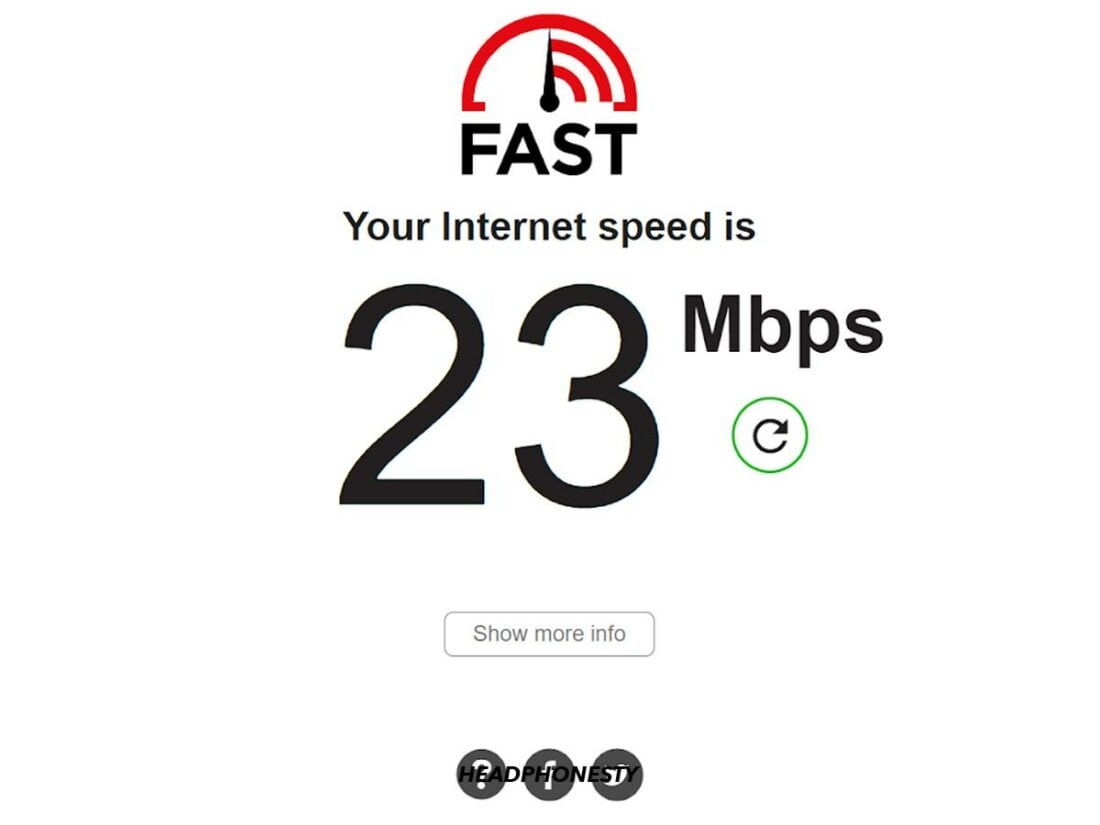
It isn’t entirely fair to the platforms to make that test, as Qobuz’s Hi-Res audio quality is so much higher. However, even using the MP3 audio quality, there was still up to a second of loading time on Qobuz. It’s not much, but you will notice it while listening to a playlist or album.
Quality differences
It’s evident through statistics that the files on Qobuz are of higher quality, but what does this mean when you’re listening to music? Using the Sony WF-1000XM4 wireless earbuds, we tested a variety of tracks in Qobuz’s Hi-Res and Spotify’s Very High formats.

The results are that the Hi-Res audio setting is much better. The soundstage is wider and clearer, and the bass is deeper and more punchy. Overall, the tracks just sound so much better in Hi-Res.
You can hear the separation between the different instruments, and the increased bit depth gives extra punch to the louder parts of the track. This gives the impression of louder audio at the same volume.
Your enjoyment of an audio track is entirely subjective, but there is a reason that Hi-Res streaming is so important to audiophiles. It’s not just a matter of statistics: you really can tell the difference between the different audio qualities.
Verdict: Which is more worth it?
Since it’s the platform’s main focus, it’s unsurprising that Qobuz would come out on top in this category. The difference between the qualities available is just too noticeable to put Spotify on par with Qobuz in audio quality.
However, that doesn’t mean that Spotify’s sound is necessarily low quality. Even the Normal quality audio is perfectly serviceable for the casual listener. It’s only in comparison to the exceptional quality of Qobuz that Spotify is lacking.
Music Discovery
Finding new music is an essential part of a streaming platform– that’s why the Discover page is a staple of both platforms. Spotify is renowned for its excellent music discovery features, but how does Qobuz compare?
Personalized recommendations
A streaming platform’s algorithm is one of the most critical tools for music discovery. This tool recommends music based on what you’re already listening to but have not heard. If the algorithm isn’t good at determining what you like, your recommendations won’t be relevant to your listening habits.
You’ll usually find these recommendations on the home or discover page, in personalized playlists, and in auto-play tracks.

In this aspect, Spotify is always ahead of the game. They have one of the most advanced algorithms, with a three-pronged approach to music recommendations: natural language processing, audio modeling, and collaborative filtering.
Spotify’s natural language processing trawls the internet for text written about specific songs and artists to find out what people are saying. It can analyze the language used to describe a certain song and use it to tag the track, which is then used to recommend music described in similar terms.
The audio modeling aspect of the algorithm analyzes every track’s audio profile, recording information like the tempo, time signature, key, loudness, etc. This lets Spotify recommend music similar to what you already like.
Finally, there’s Spotify’s collaborative filtering tool. This works by comparing the music you listen to with other people’s listening habits and finding users with similar tastes. Then, Spotify can show you the tracks that people with similar listening habits like that you haven’t heard yet.
This results in a refined and highly personal algorithm that gives you specialized and accurate recommendations. These algorithmic recommendations are why many people use Spotify for their music discovery, especially for the Discover Weekly playlist.

Qobuz, on the other hand, has partnered with Musimap to create an algorithm based on the similarities between artists, albums, and tracks, as well as a complex tagging system that records keywords, sub-genres, moods, and listening contexts.
This algorithm results in recommendations based on your general listening habits, which can be less accurate because it’s based on less precise measurements. Some users complain about their recommendations being unrelated to what they’re listening to at the time.

However, some enjoy that liking a particular song or album outside of their usual listening habits won’t affect their recommendations. This lets you enjoy one track in a different genre without worrying about it skewing your recommendations toward that type of music.
In terms of algorithmic music discovery, Spotify comes out on top. They have hundreds of playlists available for you based on your past listening, including daily mixes and discovery playlists to give you regular access to new music. If you want to find more music like the tracks you love, Spotify’s algorithm will be your friend.
Other discovery features
Personalized recommendations based on algorithmic data aren’t the only way to find new music. There are also editorial playlists, new releases, and user-created playlists.
Editorial playlists refer to the human-curated playlists available on each platform– specifically, those made by actual employees designed for a particular listening experience. These playlists are useful if you want to branch out into a new type of music, as they can act like a guided tour of an artist or genre.
These playlists usually come in the forms of top hits, artist explorations, mood or event playlists, and other platform-created playlists. They’re available on the Spotify home page, often mixed in with your recommendations, and under the Qobuz Playlists section of the discover tab.

In this area, Qobuz is the clear winner. They have hundreds of unique editorial playlists that you can use to take a deep dive into any corner of the music world through a specific artist, era, or genre. These playlists often come with a unique description to help you understand more about the context of the tracks.
Searching through new releases is also a great way to discover new music. You can find boundary-pushing tracks and up-and-coming artists this way, though you aren’t likely to find music in a specific genre or tone.

Again, Qobuz comes out on top here. New releases are front and center on their discover page, and you can easily click through to an album or artist. They also have a New Releases playlist in the Qobuz Playlists section, where you can listen to a wide selection of fresh tracks.
Spotify also has New Releases and Hot New Sounds sections on their homepage, but you’ll need to scroll through the recommendations to search them out.

Finally, there are user-created playlists. Though it’s not entirely fair to judge the quality of a platform’s music discovery based on the creations of its users, the community is a big factor in finding new music. Therefore, user-created playlists are worth mentioning.
Spotify has over four billion playlists, most of which are user-created. This means you’ll find several long, thorough, regularly updated playlists in even the most niche genre.
On the other hand, Qobuz has a far smaller user base and fewer user-created playlists available. There’s still plenty available, though– numbers haven’t been released, but you can find hundreds of user-created playlists through the search feature. There’s just not as wide a selection as on Spotify.
Verdict: Which is more worth it?
Both platforms are good for music discovery but in different ways.
If you’re looking to expand your collection of music with more similar tracks, Spotify’s refined algorithms will be the most useful. However, suppose you’re looking to branch out and discover new music in different genres. In that case, the editorial playlists and new releases on Qobuz will make it easy to find a new niche.
Ease of Use
The user interface of a streaming service is essential in making your experience streamlined and simple. Let’s compare the desktop and mobile apps of Spotify and Qobuz.
Qobuz
Desktop
Qobuz’s desktop app is arranged into tabs and a search bar at the top of your screen, with the Discover page acting as a homepage. The interface is busy but functional, with lots of filters, sub-tabs, and pop-up menus you can use to refine what you’re looking for.
The interface works, but it looks a little clunky and slightly dated.
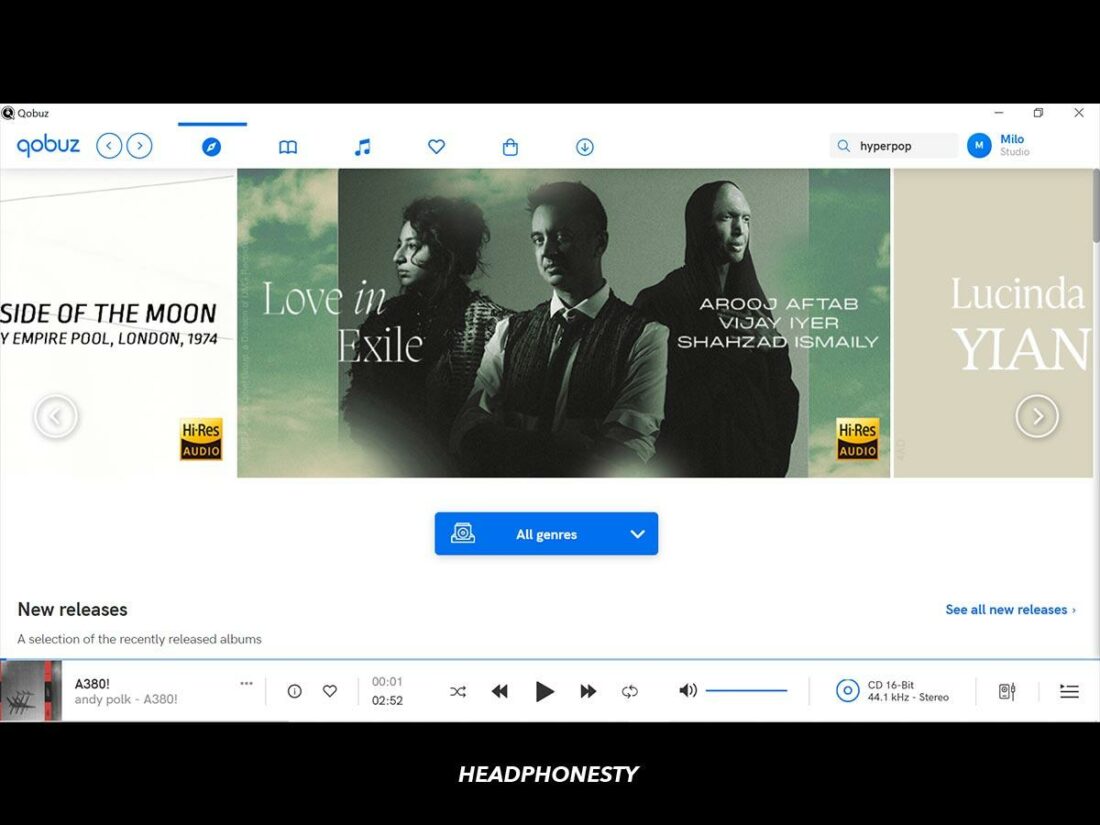
Using Qobuz is easy to use once you get used to it– in fact, it might even be even more convenient than Spotify. Though the many tabs and menus can seem intimidating at first, it’s all very logical and makes it easy to find whatever you’re looking for.
Your saved tracks, playlists, and albums are available from the tabs at the top of the screen, and you can search through each to find something specific. However, the fact that your playlists, favorite albums, purchased albums, and downloads are all in completely different tabs can be irritating, even though it makes sense under the system Qobuz uses.

The search function is easily filterable, and you can add tags to your search to refine it by music quality, release date, and explicit content. Your results are sorted by content type, as well as having a helpful Most Popular section at the top.

The Discover tab is divided into distinct sections so that you can look through new releases, personal recommendations, and editorial content separately.
Overall, using Qobuz can feel a little clunky, but very logical and clear. There aren’t any hidden features, and everything is separated and categorized according to a strict system, even when breaking a few rules might make the user experience faster and simpler.
Mobile
Both mobile apps have chosen the same basic layout: key tabs at the bottom of the screen that you can use to tap through to the relevant parts of the app. You’ll find your library, search bar, home/discover page here, and the Qobuz magazine.

Despite this similarity in design, the Qobuz app feels clunky and inefficient compared to Spotify, with headings and menus taking up a large part of the screen and your playlists and tracks locked behind several tabs.
In essence, the Spotify mobile app is designed for the smartphone. The Qobuz mobile app is adapted from the desktop version.
The most obvious example of this is the My Qobuz section. On the Spotify app, your liked songs, followed playlists, offline files, and all the other music you want to save is condensed into the easy-to-navigate My Library tab.
However, if you tap the My Qobuz tab at the bottom of your screen, the app will take you to a sub-menu where you can choose between your playlists, favorites, and purchases. Your offline library is in an entirely different tab you have to select from the bottom of your screen.

Spotify
Desktop
Design-wise, the Spotify and Qobuz desktop apps look very different. In contrast to Qobuz’s rather clunky interface, Spotify is a bit simpler and more streamlined.
Your homepage shows the most relevant information, from your most recent playlists and tracks to your personalized recommendations. There’s a menu at the side you can use to navigate to your library or liked songs, search the platform, or create a new playlist. All in all, it just looks sleeker and more modern.

However, the apps aren’t all that different when it comes to functionality. Many of the features are similar, if not identical, and you wouldn’t struggle to switch from one app to the other.
Spotify, in contrast to Qobuz, feels more immediately intuitive. You don’t have to think about where you might have saved something, as it’s instantly available on the homepage and in your library.
You can look through your recently played or browse through recommendations without having to click into tabs and sub-tabs and can access all of your playlists through the sidebar.
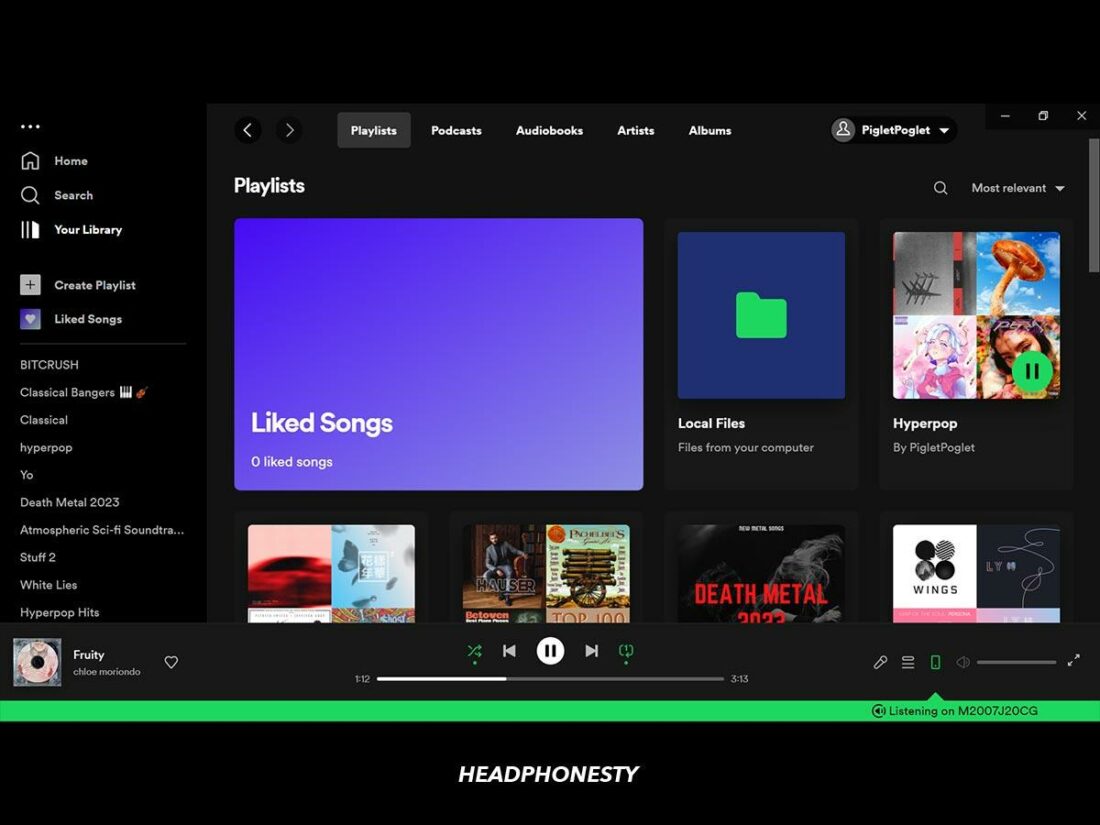
In your library, you can filter by content type and sort your tracks and playlists into several different orders, such as alphabetically, by relevance, or recently played. Your local files are also available here, as well as your liked songs.
The search function is divided by content type but has a browse function that lets you look through everything available in a specific genre or mood.

Though it’s not as clearly laid out into tabs and subheadings as Qobuz, Spotify doesn’t need to be. It’s designed to be user-friendly for even the most casual listener. However, that makes it less logical and cohesive on deeper inspection, as ease of use is prioritized over a strict system.
However, the differences aren’t that noticeable when using the apps. Most of the functions are the same: liking songs or playlists, searching for tracks or albums, or controlling the playback of your music. The most glaring differences between the apps are in Spotify’s sleeker design and Qobuz’s more thorough filing system.
Mobile
Regarding appearance and design, the mobile apps are much more similar to one another than the desktop apps. They are quite different in appearance, with the Spotify app looking a little sleeker and less intimidating, with fewer complex tabs and sub-headings.
However, it still follows the same basic design of tabs at the bottom that you can tap on to navigate to their respective page.

However, the apps are quite different in functionality. The Spotify mobile app feels far more modern than the Qobuz app, with little things like headers that disappear when you scroll and the ability to swipe through tracks adding up to an app that feels designed for the modern phone.
Though you can accomplish the same tasks, such as liking songs and streaming your playlists, you’ll find the Spotify mobile app much more intuitive, convenient, and user-friendly.
Verdict: Which is more worth it?
Spotify is the winner when it comes to ease of use because of how user-friendly it is. Both the mobile and desktop apps feel intuitive and modern, and you can find the relevant tracks and playlists with ease on the homepage.
Qobuz isn’t hard to use, but it’s less streamlined and convenient. You have to click through different tabs to find your playlists and tracks, and though it’s easy to understand, it’s not smooth or fast.
Additional Features
Plenty of other features come with streaming services that can enhance your listening experience. Let’s look at some of them:
Qobuz’s additional features
The first notable additional feature of Qobuz is how well it works with Roon. Roon is a unique music playback service, available for a monthly subscription or one-time purchase. It lets you organize and sort your tracks and offers integrated streaming for extra convenience.
Secondly, Qobuz also offers album booklets– additional written content that provides more information about the album and artists. If an album you’ve purchased has a booklet available, you can download it for free from Qobuz in a PDF format.
Finally, there’s the broad audio device compatibility. Qobuz is compatible with many audio devices, such as speakers, headphones, and smart TVs. It’s also compatible with Apple CarPlay and Android Auto. You can check out the Audio section of the Our Ecosystem tab for a complete list of compatible devices and brands.
Spotify’s additional features
One of Spotify’s most notable additional features is Spotify Wrapped, which offers a yearly roundup of your personal stats. This includes a look at your listening habits, favorite artists, and top tracks.
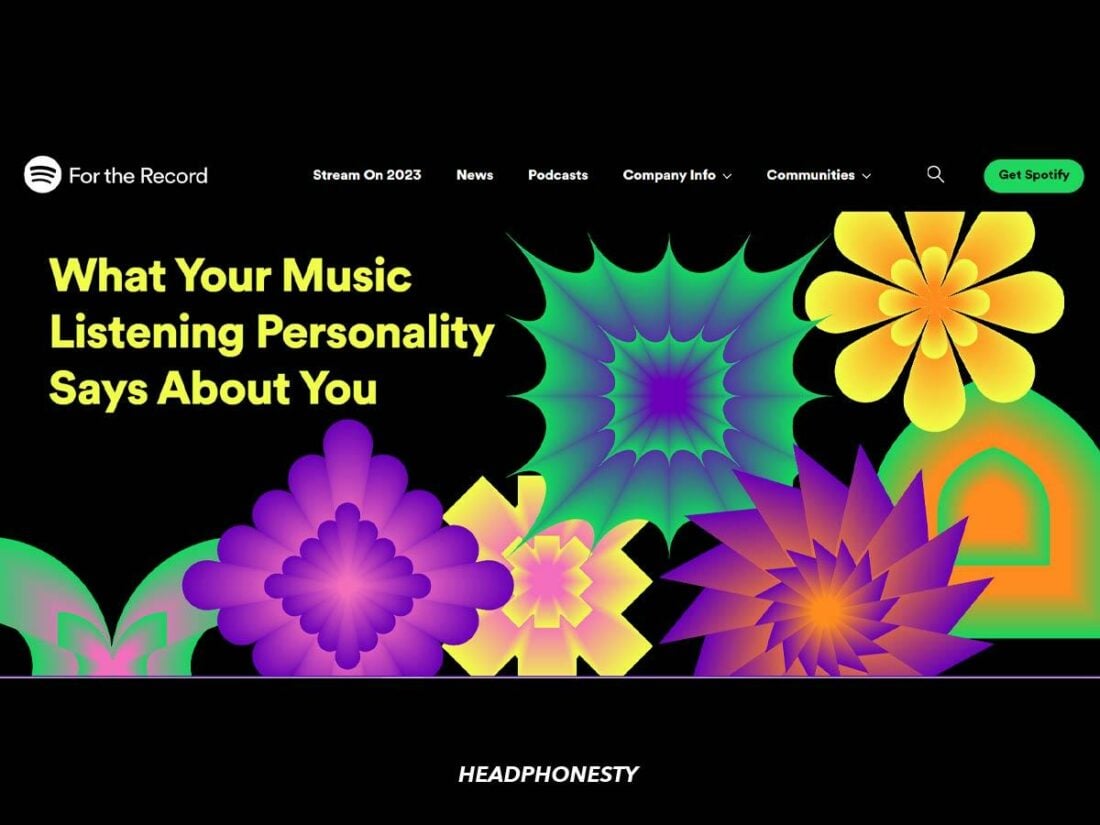
An upcoming feature that you might be interested in is Spotify HiFi. Though HiFi streaming isn’t available on Spotify yet, it has been announced as a coming feature since February 2021.
A convenient feature of Spotify you might not know about is Spotify Connect. This feature lets you use the Spotify app like a remote to switch between compatible devices. With just a few taps on your phone, you can seamlessly switch between speakers, headphones, or other audio playback devices like your car speakers.
Finally, there’s the Spotify Lyrics and Story feature. Spotify has partnered with Genius and Musixmatch to create a live lyrics feature that will let you read along to compatible tracks. Additionally, the Story Behind the Lyrics section can also offer additional information about the track, such as background and trivia.

Verdict: Which is more worth it?
Though Qobuz has several great additional features, they all involve a separate purchase. Roon is a subscription service, and you have to buy an album to have access to the booklet.
Spotify, on the other hand, has several great features built into the service that you can access for free or for no additional purchase. This makes Spotify more worth it when it comes to additional features.
How Much Do Qobuz and Spotify Pay Artists?
The amount a platform pays its artists can be a big concern regarding streaming. You want to ensure that your favorite artists are paid fairly for their work.
Here’s how much the artists on Qobuz and Spotify get paid compared to other platforms:
| Platform | Pay per stream | Streams to get $1,000 |
|---|---|---|
| Tidal | $0.013 | 76,924 |
| Apple Music | $0.01 | 100,000 |
| Amazon Music | $0.004 | 250,000 |
| Spotify | $0.0032 | 312,500 |
| Youtube Music | $0.008 | 125,000 |
| Pandora | $0.0013 | 769,231 |
| Deezer | $0.0064 | 156,250 |
| Qobuz | $0.043 | 23,255 |
Additionally, during the first lockdown, Qobuz stepped back from commissions and gave the artists 100% of the profits from music downloads.
The division of Spotify royalties is complicated, but in essence, it works on a fractional system. Spotify’s total profits are added up, then divided between artists based on how many streams their tracks have. This means that the artists’ payment is dependent on how much money Spotify makes.
However, Qobuz pays its artists on a per-stream basis. This means that artists will be paid a steady rate depending solely on how well their tracks do.
Verdict: Which is more worth it?
Spotify’s payment is a matter of constant controversy, and many claim that the service underpays artists.
In contrast, Qobuz is known for being one of the best streaming services out there for payment rates. If you want to support your favorite artists, then Qobuz is the better option.
Which Should You Go For?
Now you know all the relevant information about Qobuz and Spotify, which should you go for? Here’s the condensed list of the benefits of both platforms:
| Qobuz Premium | Spotify Premium |
|---|---|
|
|
In essence, Qobuz is great for dedicated music enthusiasts. The audio quality is high, and you can find new music in genres you might not have considered at all. Qobuz excels at providing high-quality audio and integrated streaming.
Spotify is better for casual listeners. It’s more intuitive, cheaper, and can expand your collection of similar music. You’ll also have access to a wide variety of podcasts and other audio content. Spotify is great at making streaming convenient and giving you great recommendations.
Conclusion
All in all, neither platform is necessarily better than the other, but they do appeal to different audiences. Spotify is more suited to a wider audience, while Qobuz works best for the more niche community of audiophiles.
With this review, you should now know about the relevant similarities and differences between the platforms and can decide which is better suited to your needs.
Which service do you think is better, and why? Did we miss anything important? Make sure to tell us in the comments below!
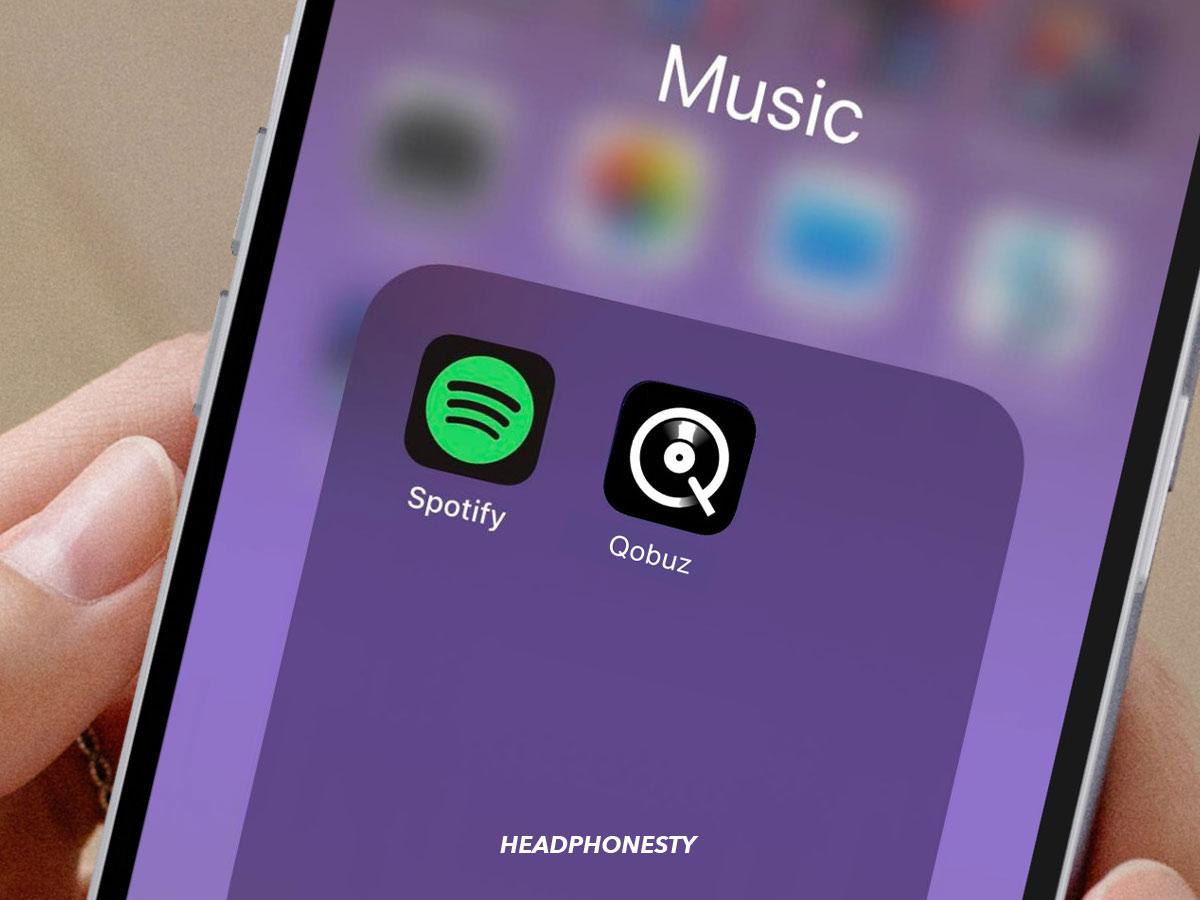
It’s apples and oranges. Spotify is unmatched for discovery and suggestion algorithms. It’s catalogue is massive covering obscure genres forgotten by the other services. Qobuz excels in the sheer quality of the albums that it holds. It is also a must, so I use them both!
I have switched between Qobuz & Tidal for a number of years, using high quality headphones and Hi Fi equipment. I was recently. recommended Spotify by an audiophile in the Hi Fi retail trade. He said that he often found listening to music of all genres more engaging with Spotify, saying it had better pace and timing than the Hi Res competition..
I therefore recently subscribed to Spotify premium to compare it with Qobuz for sound quality, using a Wiims Pro streamer and external dac To my surprise I find that I agree with him. Smaller soundstage, with a more solid rather than transparent sound picture, a bit like sitting in the mid stalls rather than up close to the musicians and hearing every detail. No doubt hearing ability, equipment and listening environment can be factors here but I am often enjoying my music more with Spotify. Both sound extremely good, but in different ways. It’s subtle yes, but I certainly don’t seem to miss the more open and extended top end that Qobuz can offer. Perhaps I am just listening to the music!
So having compared both over the last three weeks and read your excellent comparison review, I still can’t decide which streaming service to drop. Will probably keep both for the time being!
PS to the above.
Spotify currently has a big advantage over Qobuz in one respect concerning many classical box sets. Take for example Beethoven’s 5 piano concertos. These are clearly numbered in the same order as they are recorded on the cds. Qobuz however does not show any numbering, just a continuous list of movements, so a listener not familiar with the works, would not know to what concerto they were listening. I recently complained to Qobuz and was told that they hope to address this at some time in the future. What a glaring omission and something they should have addressed years ago.